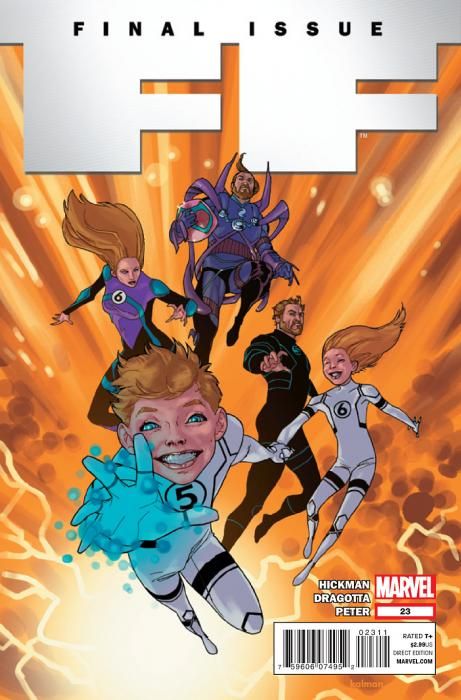"FF" #23, written by Jonathan Hickman and drawn by Nick Dragotta, is the last issue of the "Fantastic Four" spin-off. With any ending, there's the question of whether writers are given enough notice and have enough skill to do justice to their storylines and to the characters. Hickman has given himself the luxury of a whole issue to say goodbyes, and he got to do "FF" #23 his way, which is good news for everyone.
Future Franklin Richards has one more training session with his younger self and Leech, and their trip into a pocket universe it turns into something like a dad and kids' day out where dad buys the kids everything in the candy store because he knows he'll have to leave soon. What's inside the Future Foundation candy store, then? Hickman and Dragotta go delightfully wild with ideas. To detail everything would take forever and spoil the fun, but here's a taste: there's a Moloid Philharmonic. "FF" does family "quality time" better than anyone.
The visuals of the pocket universe are not only exquisite and witty by themselves, but they showcase Franklin Richards' reality-bending powers that require both literary and visual imagination to do them justice. Dragotta and colorist Cris Peter match bright, lovely images to Hickman's wit and tone. Dragotta's composition is also excellent, with thoughtful, dramatic use of negative space, and he draws some excellent dinosaurs and dragons.
Peter has different color schemes for each panel in the pocket universe, and her work amplifies the beauty of certain panels, especially one in which Leech, Franklin and Future Franklin zoom upwards together through a landscape of birds and trees. Peter also shows care in matching her hues to the tone of Hickman's script. Before going into the pocket universe, colors were muted and neutral; afterwards, landscapes are suddenly vivid and bright, and the ending scenes are colored in stark, high-contrast, black and white and shadows.
"FF" #23 also shows how good Hickman is about writing to his artist's strengths, while still firmly controlling the direction of the plot and the complexity of content. Still, Hickman is lucky that Dragotta is talented enough for an issue so heavy on emotion. In one scene, Leech's face goes from dour to confident quickly and believably due to Dragotta's skill with facial expressions, and Future Franklin's controlled, resigned sadness is apparent throughout "FF" #23, especially in a panel where he waves to Young Valeria.
Despite a bittersweet undercurrent, Hickman keeps the mood mostly light. His humor shines in a bar scene farewell between the adults, and he's canny enough to have The Thing call him out on what he's doing as a writer -- "nostalgic stories about fake futures," yet this meta-awareness isn't pretentious, but salts the sentimentality of the scene with some irony.
Unfortunately, even with these strengths, "FF" #23 feels stretched across an unnatural frame. Hickman has chosen to end things quietly instead of filling the pages with action. It's the more difficult road, and thus "FF" #23 is tasked with giving readers a believably happy ending and spotlighting all major characters in a way that sums them up. "FF" #23 does these things, but it is also a stage where the reader can often feel the hand behind the curtain pushing buttons, especially on the very last page. If there's anything wrong with "FF" #23, it's that it feels intermittently manipulative and forcibly wholesome, even trite.
However, the artifice doesn't look awful -- not with Dragotta's art. The issue serves as a delivery vehicle for Hickman's truly moving moments. In the penultimate scene, Susan Richards' "Wait!" and her last, anxious question to Future Franklin is beautifully phrased and psychologically potent; totally in character, yet still unexpected.
"FF" has been an uneven title, but this last issue plays to its strengths: imagination, light-hearted humor and relationships between family and friends.

